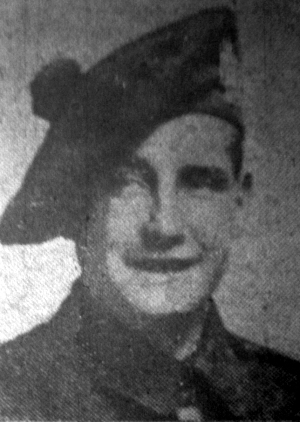
Ernest Dews was born at Horbury Bridge in 1888, the son of John Henry Dews and his wife Mary Amelia (nee Howson) who were married in 1878 at Ossett. Ernest’s father, John Henry died in 1905 at the age of 48, leaving his wife Mary with four children to bring up. In 1911, the Dews family are living at 15, Park Street, Park Square, Ossett and 21 year-old Ernest is working as a willier. The head of household is Mary Amelia Dews with three other children: Sarah Ann, Gertrude and his elder brother Hubert Dews, then aged 18, who was also destined to lose his life in WW1.
On the 13th September 1913, at the South Parade Trinity Chapel, Ernest Dews, then 25 years of age and living at 15, Park Street, Ossett, a willeyer in a cloth mill married 27 year-old Minnie Hocking, a cloth weaver living at Hilda Street, Ossett. In early 1916, Minnie Dews gave birth to a daughter, Leonora A. Dews who remained a spinster and died in Horbury in 1957 aged 42.
Ernest Dews enlisted with the 6th Battalion, King’s Own Scottish Borderers, which was formed in Berwick upon Tweed in August 1914 and they landed in Boulogne on the 12th May 1915. In May 1916, the 6th Battalion was transferred to the 27th Brigade of the 9th (Scottish) Division. Between the 14th and 17th October 1918, they were involved in the Battle of Courtrai (now Kortrijk) as they advanced across the River Lys and through Ooteghem. A resumption of the final offensive against the Germans in Belgium on the 14th October 1918 marked the beginning of what came to be called the Battle of Courtrai.
As part of a general advance towards Ghent (now Gent), three corps of the British Second Army, north of the River Lys (or Leie), were given the task of securing the line of the river to beyond Courtrai (Kortrijk), in readiness for establishing bridgeheads on the south bank. The 9th (Scottish) Division, which was on the Army’s northern flank, had the greatest distance to cover. Separate attempts by three divisions to establish bridgeheads over the canalized Lys on October 16th and 17th for an advance to the River Scheldt failed in the face of determined German resistance.1

Above: Map showing the Front Line on the 16th October 1918.
Lance-Corporal Ernest Dews, aged 30 years, the son of Mr. W.H. Dews, 33 Hocking Yard, South Parade, Ossett, was killed in action on the 16th October 1918. He is buried at grave reference I. A. 4 in the Dadizeele New British Cemetery 2, Moorslede, West-Vlaanderen, Belgium. Dadizeele New British Cemetery is located 16 km east of Ieper town centre on a road leading from the N8 Meenseweg, connecting Ieper to Menen via Geluwe.
The village of Dadizeele (now Dadizele) was in German hands for much of the First World War until reached by the 36th (Ulster) Division, and taken by the 9th (Scottish) Division, on the 29th of September 1918. Severe fighting followed on the 1st of October, at Hill 41, a little south of the village.
Dadizeele New British Cemetery is in fact an extension of the communal cemetery. It was made after the Armistice when graves were brought in from other burial grounds and from the battlefields of 1918, although there are a few 1914 graves in Plot VI, Row D.
The following were burial grounds from which Commonwealth graves were transferred to Dadizeele New British Cemetery:
Black Watch Cemetery, Ledeghem, between St. Pieter and Hennekot: 34 of 9th Division (mainly 8th Royal Highlanders), who fell 14th October 1918.
Deerlyck German Cemetery, about 100 metres East of the Communal Cemetery: 2 from United Kingdom, who fell October 1918.
Mansard Farm Cemetery, Dadizeele, between Vijfwegen and Kezelberg: 39 from United Kingdom, all but one 36th Division, October to November 1918.
Molenhoek Military Cemetery, Becelaere, at South-East corner of hamlet of Molenhoek: 36th Division buried 41 from United Kingdom, September to October 1918, alongside a large German Cemetery.
Railway Crossing Cemetery, Dadizeele, on the Dadizeelehoek Klephoek road, 100 metres West of “Teofani” railway crossing, by “Kirton Farm”: 18 of 9th and 36th Divisions, fell 14th October 1918.
Terhand German Cemetery, Gheluwe, 100 metres South of Terhand: 28 from United Kingdom, October 1918, mainly 36th and 35th Divisions.
Townsend Farm Cemetery, Ledeghem, on left of railway 500 metres North of Ledeghem station: 12 from United Kingdom and six from Newfoundland, all 9th Division, September to October 1918.
Waterdamhoek German Cemetery, Moorslede, 300 metres West of Waterdamhoek: 29 from United Kingdom and 9 from Newfoundland, all 9th Division, October 1918.
The cemetery contains 1,029 Commonwealth burials and commemorations of the First World War. 158 of the burials are unidentified and there are special memorials to seven casualties known or believed to be buried in the cemetery. Other special memorials bear the names of three soldiers buried in German cemeteries, whose graves could not be found on concentration.